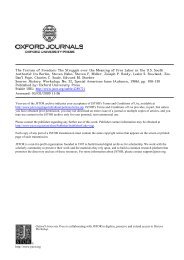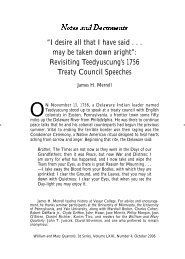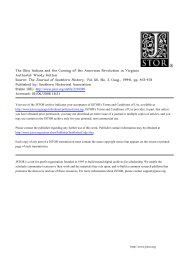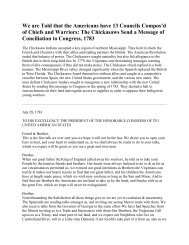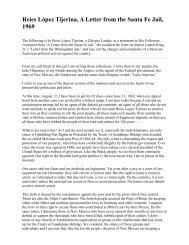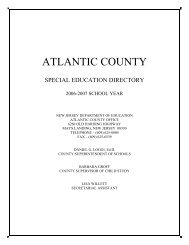A Historical and Regional Overview of Latinas in the United ... - CUNY
A Historical and Regional Overview of Latinas in the United ... - CUNY
A Historical and Regional Overview of Latinas in the United ... - CUNY
Create successful ePaper yourself
Turn your PDF publications into a flip-book with our unique Google optimized e-Paper software.
Introduction: A <strong>Historical</strong> <strong>and</strong> <strong>Regional</strong> <strong>Overview</strong><br />
penses <strong>of</strong> major appliances that <strong>the</strong>y traded from<br />
house to house. These networks <strong>of</strong> family <strong>and</strong> friends<br />
were crucial to women who worked outside <strong>the</strong> home.<br />
Although women exp<strong>and</strong>ed <strong>the</strong>ir roles to <strong>in</strong>clude wage<br />
earn<strong>in</strong>g, <strong>the</strong>ir spouses did not exp<strong>and</strong> <strong>the</strong>ir roles to <strong>in</strong>clude<br />
housework. Elderly women, <strong>in</strong> particular, played<br />
a crucial role <strong>in</strong> this network. In three-generation<br />
households <strong>the</strong> elderly supplied an additional <strong>in</strong>come<br />
from ei<strong>the</strong>r outside employment or public assistance,<br />
which, <strong>in</strong> turn, helped assist <strong>the</strong>ir families f<strong>in</strong>ancially.<br />
More important, <strong>the</strong>y played a pivotal role <strong>in</strong> child<br />
rear<strong>in</strong>g <strong>and</strong> home ma<strong>in</strong>tenance, allow<strong>in</strong>g <strong>the</strong>ir daughters,<br />
gr<strong>and</strong>daughters, <strong>and</strong> neighbors to go out <strong>and</strong> f<strong>in</strong>d<br />
work.<br />
Some entrepreneurial women created lucrative<br />
bus<strong>in</strong>esses that catered to <strong>the</strong> needs <strong>of</strong> women who<br />
entered <strong>the</strong> workplace. They established housekeep<strong>in</strong>g<br />
<strong>and</strong> delivery services, laundries <strong>and</strong> dry cleaners,<br />
home ateliers <strong>and</strong> dress shops, beauty parlors, daycare<br />
centers, driv<strong>in</strong>g schools, <strong>and</strong> even subscription<br />
home-delivery food services. Cubans discovered that<br />
any bus<strong>in</strong>ess that made life easier for women who<br />
worked outside <strong>the</strong> home had a good chance <strong>of</strong> succeed<strong>in</strong>g.<br />
The shift <strong>in</strong> roles <strong>and</strong> responsibilities has had a<br />
tremendous impact on Cubans’ economic “success” as<br />
a group. As early as 1980 Cuban American median<br />
family <strong>in</strong>come was almost equal to that <strong>of</strong> <strong>the</strong> total U.S.<br />
population. This was an important accomplishment for<br />
a community <strong>of</strong> predom<strong>in</strong>antly first-generation immigrants.<br />
Women’s high participation <strong>in</strong> <strong>the</strong> labor force<br />
helped raise <strong>the</strong> median family <strong>in</strong>come. Without <strong>the</strong>ir<br />
contributions, <strong>the</strong>se statistics would have been much<br />
different. While women’s new roles brought <strong>the</strong>m <strong>in</strong>dependence<br />
<strong>and</strong> power, it also stra<strong>in</strong>ed marriages because<br />
many men felt threatened by <strong>the</strong>se nontraditional<br />
relationships. By 1980 census figures showed<br />
that Cuban women had <strong>the</strong> highest divorce rates <strong>in</strong> <strong>the</strong><br />
<strong>United</strong> States: 9.3 percent <strong>of</strong> Cuban women aged fifteen<br />
years <strong>and</strong> above identified <strong>the</strong>mselves as divorced<br />
<strong>in</strong> <strong>the</strong> 1980 census, as compared with 7.3 <strong>of</strong> <strong>the</strong> total<br />
U.S. population.<br />
While women’s participation <strong>in</strong> <strong>the</strong> labor force had<br />
a notable impact on <strong>the</strong> economic success <strong>of</strong> both <strong>the</strong>ir<br />
families <strong>and</strong> <strong>the</strong> larger community, <strong>the</strong>ir participation<br />
<strong>in</strong> <strong>the</strong> political activities <strong>of</strong> <strong>the</strong> community was less obvious.<br />
Dur<strong>in</strong>g <strong>the</strong> 1960s exile politics was concerned<br />
more with Cuba than with <strong>the</strong> <strong>United</strong> States, <strong>and</strong> hundreds<br />
<strong>of</strong> political organizations emerged <strong>in</strong> Miami,<br />
Union City, New York, Los Angeles, <strong>and</strong> Chicago to<br />
lead <strong>the</strong> counterrevolution. S<strong>in</strong>ce politics was generally<br />
regarded as too hostile or violent an arena for<br />
women, for <strong>the</strong> most part, <strong>the</strong>y were excluded from<br />
<strong>the</strong>se organizations. The vast majority <strong>of</strong> women were<br />
also too preoccupied with domestic <strong>and</strong> economic re-<br />
22<br />
q<br />
sponsibilities to be full-time advocates <strong>of</strong> la causa<br />
cubana. Tradition cast <strong>the</strong>m <strong>in</strong> a supportive role. They<br />
could always be counted on to do <strong>the</strong> thankless <strong>and</strong> tedious<br />
work <strong>of</strong> sew<strong>in</strong>g or pa<strong>in</strong>t<strong>in</strong>g banners, prepar<strong>in</strong>g<br />
food for protesters at demonstrations, writ<strong>in</strong>g letters<br />
<strong>and</strong> mak<strong>in</strong>g phone calls, <strong>and</strong> march<strong>in</strong>g <strong>in</strong> demonstrations.<br />
The h<strong>and</strong>ful <strong>of</strong> political organizations that<br />
emerged exclusively for women, among <strong>the</strong>m <strong>the</strong><br />
Union de Mujeres, <strong>the</strong> Cruzada Femen<strong>in</strong>a Cubana, <strong>and</strong><br />
<strong>the</strong> Movimiento Femen<strong>in</strong>o Anticomunista de Cuba,<br />
functioned as auxiliaries, provid<strong>in</strong>g moral <strong>and</strong> f<strong>in</strong>ancial<br />
support to different men’s organizations by participat<strong>in</strong>g<br />
<strong>in</strong> <strong>the</strong>ir rallies <strong>and</strong> fund-raisers, organiz<strong>in</strong>g public<br />
relations campaigns <strong>and</strong> membership drives, <strong>and</strong> even<br />
sponsor<strong>in</strong>g memorial services for <strong>the</strong> men who died<br />
for la causa. These organizations, however, <strong>of</strong>fered no<br />
real political alternatives.<br />
The one political issue that drew a significant participation<br />
from women was human rights. Numerous<br />
coalitions emerged dedicated to call<strong>in</strong>g world attention<br />
to <strong>the</strong> plight <strong>of</strong> political prisoners <strong>in</strong> Cuba. Perhaps<br />
<strong>the</strong> most notable <strong>of</strong> <strong>the</strong>se groups was <strong>the</strong> nonpr<strong>of</strong>it organization<br />
Of Human Rights, founded <strong>in</strong> 1961 by Elena<br />
Mederos González to monitor human rights abuses <strong>in</strong><br />
Cuba. O<strong>the</strong>r groups that have emerged <strong>in</strong>clude <strong>the</strong><br />
Committee to Denounce Cruelties to Cuban Political<br />
Prisoners, <strong>the</strong> Centro de Derechos Humanos del<br />
Movimiento Demócrata Cristiano, <strong>and</strong> El Movimiento<br />
Mujeres pro Derechos Humanos. Women played a crucial<br />
role <strong>in</strong> this political campaign, s<strong>in</strong>ce it was <strong>the</strong>ir fa<strong>the</strong>rs,<br />
husb<strong>and</strong>s, sons, <strong>and</strong> sisters who were imprisoned<br />
<strong>in</strong> Cuba. They wrote letters <strong>and</strong> sent petitions to<br />
Amnesty International, Americas Watch, <strong>the</strong> International<br />
Red Cross, <strong>and</strong> <strong>the</strong> PEN clubs, <strong>and</strong> <strong>the</strong>y met with<br />
presidents, congressmen, <strong>and</strong> foreign dignitaries. They<br />
organized fund-rais<strong>in</strong>g banquets to raise money for<br />
<strong>the</strong>ir publicity campaign, arranged special memorial<br />
services to pray for <strong>the</strong> prisoners, <strong>and</strong> helped erect<br />
monuments honor<strong>in</strong>g <strong>the</strong> prisoners <strong>in</strong> parks <strong>and</strong> public<br />
areas to keep <strong>the</strong>m <strong>in</strong> <strong>the</strong> community’s consciousness.<br />
It took years, however, to see <strong>the</strong> fruits <strong>of</strong> <strong>the</strong>ir work. It<br />
was not until <strong>the</strong> late 1970s <strong>and</strong> early 1980s that <strong>the</strong><br />
Castro government f<strong>in</strong>ally began to release thous<strong>and</strong>s<br />
<strong>of</strong> political prisoners.<br />
Younger women who came <strong>of</strong> age <strong>in</strong> <strong>the</strong> <strong>United</strong><br />
States <strong>and</strong> studied at U.S. colleges <strong>and</strong> universities<br />
tended to have greater opportunities for political expression<br />
than <strong>the</strong>ir mo<strong>the</strong>rs. Influenced by <strong>the</strong> civil<br />
rights movement, <strong>the</strong> fem<strong>in</strong>ist movement, <strong>and</strong> <strong>the</strong> student<br />
activism <strong>of</strong> <strong>the</strong> 1960s <strong>and</strong> early 1970s, <strong>the</strong>y jo<strong>in</strong>ed<br />
various student political groups <strong>and</strong> staged protests<br />
<strong>and</strong> demonstrations on college campuses. Some <strong>of</strong><br />
<strong>the</strong>se younger women, <strong>in</strong>fluenced by <strong>the</strong> radicalized<br />
milieu <strong>of</strong> <strong>the</strong> 1960s, came to adopt a more tolerant<br />
view <strong>of</strong> <strong>the</strong> revolution <strong>and</strong> began to work for <strong>the</strong> nor-



